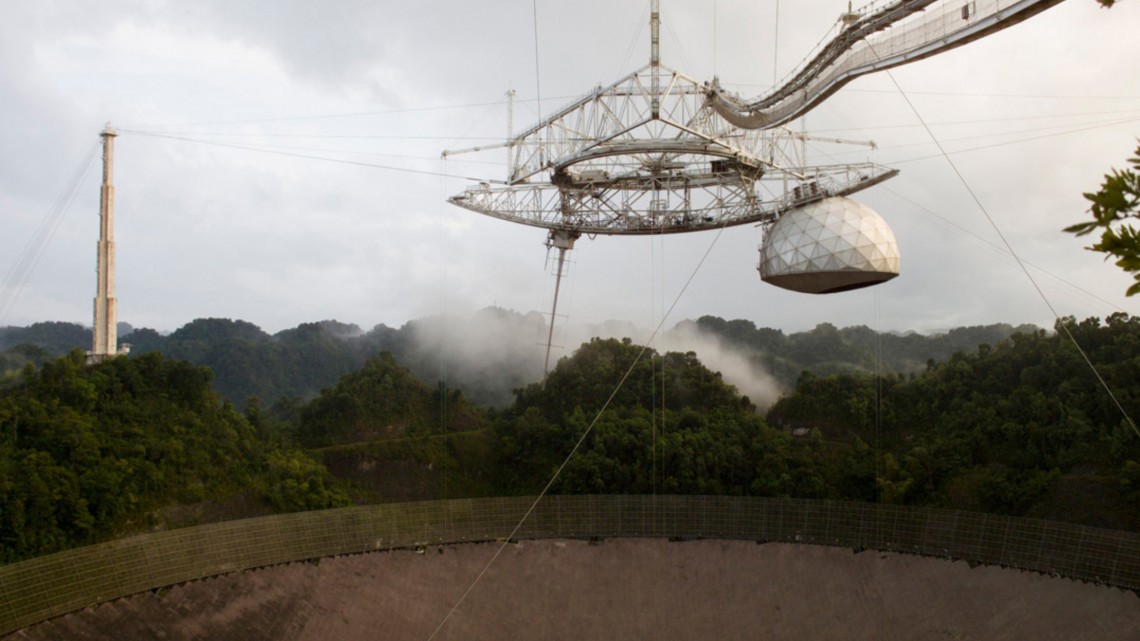
The Arecibo telescope in Arecibo, Puerto Rico, which found repeating fast radio bursts, after astronomers reviewed PALFA (Pulsar Arecibo L-Band Feed Array) survey data.
Sifting Cornell data, astronomers find repeating bursts
By Blaine Friedlander
After combing through Cornell-archived data, astronomers have discovered the pop-pop-pop of a mysterious, cosmic Gatling gun – 10 millisecond-long “fast radio bursts” – caught by the Arecibo telescope in Puerto Rico, as reported in Nature, March 2.
In the past eight years, scientists have found 17 fast radio bursts, or FRBs, and another was reported Feb. 24. Until now, scientists believed these bursts were isolated, singular events – one-time explosions from the distant corners of the universe. To their surprise, after reviewing PALFA (Pulsar Arecibo L-Band Feed Array) data from 2012, astronomers now confirm that at least some of these FRB sources emit repeated pulses.
In 2014 Laura Spitler, M.S. ’10, Ph.D. ’13, had discovered a single burst using the same data. Spitler, who developed tools and methods that enabled the new finding, works as a postdoctoral researcher at the Max Planck Institute for Radio Astronomy in Bonn, Germany, and is the paper’s first author.
Last November, McGill University doctoral student Paul Scholz sifted through new PALFA observations of the same sky position to find recurring pulses.
Cornell senior researcher Shami Chatterjee, M.S. ’00, Ph.D. ’03, and James Cordes, the George Feldstein Professor of Astronomy and Spitler’s doctoral adviser, measured the burst properties and searched for counterparts at other wavelengths.
“This research shows for the first time that there can be multiple FRBs from the same place in the sky – with the same pulse dispersion or distance,” said Chatterjee, who said this discovery rules out entire classes of theoretical models – such as explosive mergers of neutron stars – for at least this one FRB source. “Whatever produces the FRB can’t be destroyed by the burst, because otherwise, what would produce the next pulse?”
This new cosmic riddle is perplexing, said Cordes. “We’re showing that whatever battery drives FRBs, it can recharge in minutes,” he said.
“The energy of the event becomes very problematic. We’re detecting these FRBs from very far away, which means that they are intrinsically very bright. Only a few astrophysical sources can produce bursts like this, and we think they are most likely neutron stars in other galaxies,” Cordes said, based on his own theoretical analysis conducted with his colleague Ira Wasserman, Cornell professor of astronomy.
Cornell’s Center for Advanced Computing archives about 400 terabytes of PALFA data from numerous surveying projects. This mountain of data is managed by Adam Brazier, a specialist in cyber infrastructure.
Last week, astronomers in another Nature paper indicated the discovery of the 17th FRB, reporting a radio “afterglow” of a new FRB, which, explains Chatterjee, is like a mushroom cloud following a huge explosion. “In our paper, we’re showing that our FRB can’t have an explosive origin. So, either there’s an odd coincidence, or maybe there are different types of FRBs. Either way, it seems we’ve broken this enigmatic phenomenon wide open.”
Media Contact
Get Cornell news delivered right to your inbox.
Subscribe